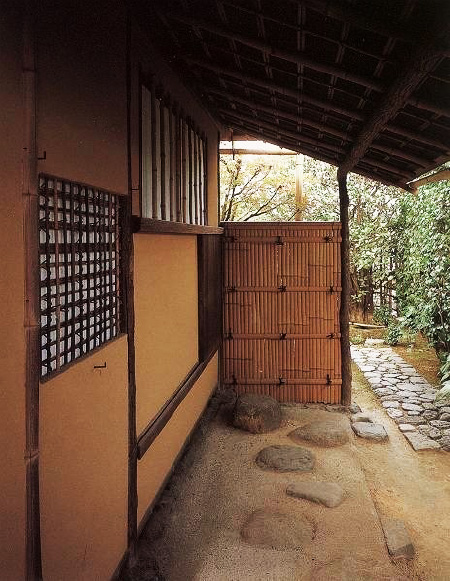

さて昨日の続篇です。
武野紹鴎が「真」書を正調四畳半として作り、その弟子の利休は
当時庶民がさかんに作ったと言われる「草」庵茶室を造作して
侘さびの表現としていったとされている。
四畳半に対して、その大きさも同じ正方形だけれどもっと狭めて
2畳敷きとしていった。写真は国宝茶室・妙喜庵待庵。


これくらいの狭さになってくると当然床の間もコンパクト化していく。
4尺いくらとかいうことなので人間の方が大きい。
入口をにじり口として小さくしたのは、全体としてのコンパクト化の帰結か。
こうして茶の湯の時間を濃密にデザインしていった。
主客の対等性は畳の面積・長さとも確保した「立って半畳寝て一畳」世界。
それこそ人間関係の虚飾をそぎ落としたいという芸術家的狂気すら感じる。
そう、時間と空間性を総合的にプロデュースするという「芸術」。
茶そのものでなく、確かに待庵は国宝指定されたけれど建築自体とも言えない。
作法や体動作なども含めた全体としての「体験」をデザインしたのでしょう。
アサガオが美しくなったので秀吉が見たいと所望したけれど、
行ってみたら周辺のアサガオの蔓草からすべて花芽が切り落とされて
不思議に思ってにじり口をくぐって中に入ったらたった1輪だけ生けられていた、
というような接遇応対自体を芸術化させたということなのでしょう。
こういう心性を何ごとにもコテコテ金ピカ趣味の秀吉がいっときは
自らの重商主義政策のシンボルとして堺衆の統御としても利用した。
けれども、こういう人間関係の「虚飾のそぎ落とし」には、
最終的に権力者として、のっぴきならないアナキズムを感じたのかも知れない。

ひるがえって、ふと「これって密そのもの」と思えてくる。
四畳半からさらに2畳への極限化は現代世界的には厳しい。
利休の時代にはビジネス会話の秘匿性、機密情報の重要性が強まって
限定少人数での「共有感」を最大化させていく方向だったのでしょう。
ビジネス上の「信頼感」の醸成ということが茶の湯のメリットだったと思える。
そもそも「堺衆」という呼び名自体、結社的な信頼関係を想起させる。
そして信頼感醸成が日本的ビジネス慣習のコアを形成していた。
いわゆる営業接触の世界では目指すべき規範だったと言えるのでしょう。
しかしこういうスタイルは21世紀の今日の社会の現状からはやや遠い。
むしろ非接触型にどんどん移行していっているのが現実。
茶道すらも非接触でZoomに移行できないかという志向の社会潮流。
Zoom飲み会という試行まで行われていた。若干行き詰まり感があるけれど(笑)。
閉じられた空間での情報共有の方向は現代では回避されている。
むしろ非接触文化をどう発展させて、利休の2畳茶室を越えられるのか。
今後社会がどういう方向を選択していくか、見通せないけれど、
そんな方向性もあり得ると想像を巡らせている必要があるかも知れませんね。
English version⬇
[Souan tea room 2 tatami mats-parent “dense” space / Japanese good house special edition ㊱-8]
Well, yesterday’s sequel.
Takeno Jōo made the “Shin” book as a regular four and a half mats, and his disciple Rikyu
Created a “Kusa” hermitage tea room, which is said to have been made by the common people at that time.
It is said that it was used as an expression of Wabi-Sabi.
It’s the same size as a square for four and a half mats, but it’s narrowed down.
I made 2 tatami mats. The photo is the national treasure tea room, Myokian Machian.
Naturally, the alcove will become more compact as it becomes as narrow as this.
Humans are bigger because it is about 4 shaku.
Is it the result of the overall compactness that the entrance was made smaller as a bleeding opening?
In this way, the time for the tea ceremony was carefully designed.
The equality of the main customers is the world of “standing, half tatami mats, sleeping one tatami mats” that secures the area and length of tatami mats.
It even feels the artist’s madness to strip away the vanity of relationships.
Yes, “art” that comprehensively produces time and space.
It is not the tea itself, but Machian is certainly designated as a national treasure, but it cannot be said to be the architecture itself.
Perhaps he designed the “experience” as a whole, including the manners and body movements.
Hideyoshi wanted to see the morning glory because it became beautiful, but
When I went there, all the flower buds were cut off from the surrounding morning glory vines.
Mysteriously, when I passed through the mouth and went inside, only one wheel was alive,
It seems that the hospitality itself was made into an art.
When Hideyoshi, who has a hobby of gold and shiny, has this kind of mentality
He also used it as a symbol of his own mercantilist policy and as the ruler of the Sakai people.
However, in this kind of “stripping off the vanity” of human relations,
In the end, as a man of power, he may have felt anarchism.
On the contrary, I suddenly think that this is dense.
The limit from four and a half tatami mats to two tatami mats is severe in the modern world.
In the Rikyu era, the confidentiality of business conversations and the importance of confidential information became stronger.
Perhaps it was the direction of maximizing the “sense of sharing” with a limited number of people.
It seems that the merit of the tea ceremony was to foster a sense of trust in the business.
In the first place, the name “Sakaishu” itself reminds us of an association of trust.
And building trust formed the core of Japanese business practices.
It can be said that it was the norm that should be aimed at in the world of so-called business contact.
However, this style is a little far from the current state of society in the 21st century.
Rather, the reality is that they are steadily shifting to non-contact types.
A social trend that aims to shift to Zoom without even contacting the tea ceremony.
There was even a trial called Zoom drinking party. I feel a little stuck (laughs).
The direction of information sharing in a closed space has been avoided in modern times.
Rather, how can we develop a non-contact culture and overcome Rikyu’s 2 tatami tea room?
I have no idea what direction society will choose in the future,
It may be necessary to imagine that such a direction is possible.
Posted on 7月 13th, 2021 by 三木 奎吾
Filed under: 住宅マーケティング, 日本社会・文化研究







コメントを投稿
「※誹謗中傷や、悪意のある書き込み、営利目的などのコメントを防ぐために、投稿された全てのコメントは一時的に保留されますのでご了承ください。」
You must be logged in to post a comment.